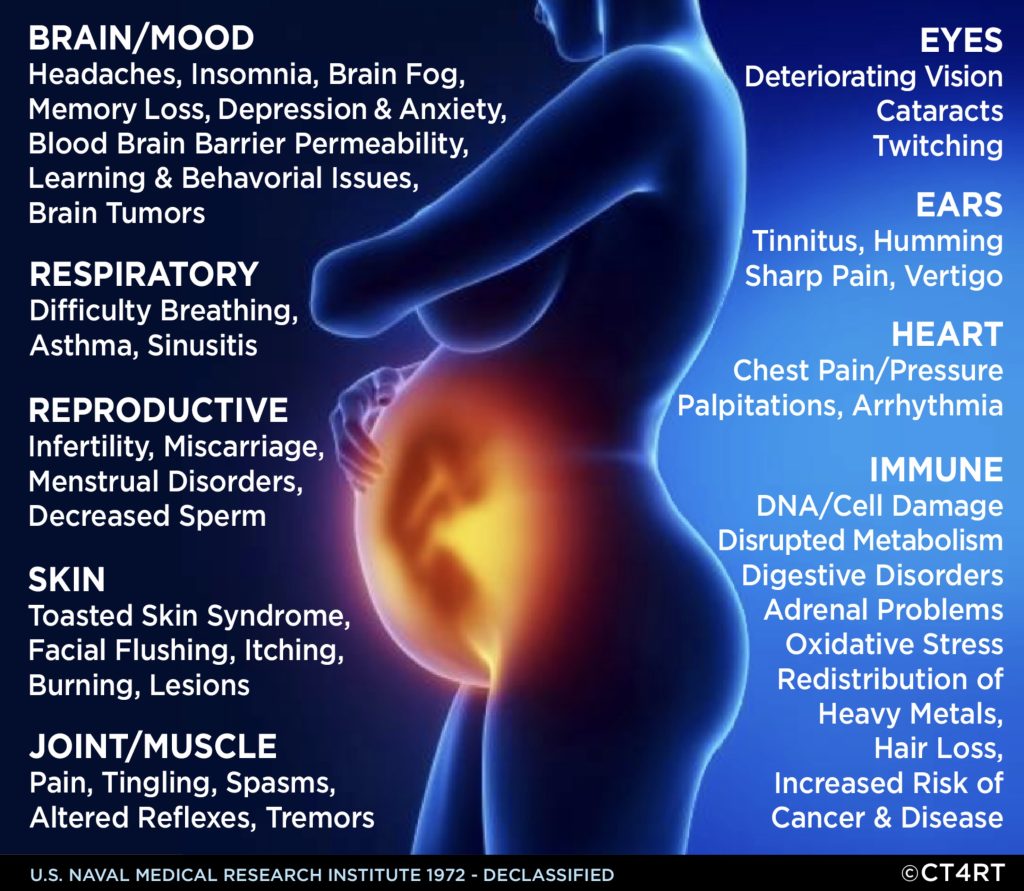The 1972 U.S. Naval Medical Research Institute Report: A Historical Look at RF Radiation Effects
In 1972, the U.S. Naval Medical Research Institute (NMRI) published a significant document titled Bibliography of Reported Biological Phenomena (‘Effects’) and Clinical Manifestations Attributed to Microwave and Radio-Frequency Radiation. Compiled by Zorach R. Glaser, Ph.D., this report cataloged over 2,000 references on the biological responses to radiofrequency (RF) and microwave radiation, with a particular focus on the effects on humans. At the time, this was a groundbreaking effort to consolidate the global literature on non-ionizing radiation, drawing from studies published up to June 1971, including detailed contributions from Soviet and East European research. The report aimed to provide guidance for understanding the diffuse and often conflicting literature on RF radiation’s biological impacts, which was critical for setting exposure limits and planning future research.

The document, which has since been declassified, is a bibliography rather than a conclusive study. It summarizes findings from various studies, many of which were preliminary, conducted on animals, or lacked the rigorous controls of modern scientific standards. Despite these limitations, the report is often cited by those concerned about the health effects of RF radiation, especially in the context of modern technologies like 4G and 5G networks, even though it predates these technologies by decades. You can access the full report through the National Technical Information Service (NTIS) archives here [Ref web ID: 18].
Effects Suggested by the 1972 Report
The report includes an outline in Chapter 1 that categorizes the biological phenomena and clinical manifestations attributed to RF and microwave radiation. Below is a comprehensive list of the effects suggested by the studies cited in the report, grouped by category as presented in the original document:
- Brain/Mood Effects:
- Headaches
- Insomnia
- Brain fog
- Memory loss
- Depression and anxiety
- Increased blood-brain barrier permeability
- Learning and behavioral issues
- Brain tumors
- Eye Effects:
- Deteriorating vision
- Cataracts
- Twitching
- Ear Effects:
- Tinnitus
- Humming
- Sharp pain
- Vertigo
- Heart Effects:
- Chest pain/pressure
- Palpitations
- Arrhythmia
- Respiratory Effects:
- Difficulty breathing
- Asthma
- Sinusitis
- Reproductive Effects:
- Infertility
- Miscarriage
- Menstrual disorders
- Decreased sperm count
- Skin Effects:
- Toasted skin syndrome (erythema ab igne)
- Facial flushing
- Itching
- Burning
- Lesions
- Joint/Muscle Effects:
- Pain
- Tingling
- Spasms
- Altered reflexes
- Tremors
- Immune and Cellular Effects:
- DNA/cell damage
- Disrupted metabolism
- Digestive disorders
- Adrenal problems
- Oxidative stress
- Redistribution of heavy metals
- Hair loss
- Increased risk of cancer and disease
These effects were not confirmed by the report as definitive outcomes of RF exposure but were instead reported as potential phenomena observed in the studies reviewed. Many of the cited studies involved exposure levels far higher than those emitted by modern telecommunications devices, and the report does not distinguish between thermal and non-thermal effects, a distinction that has become critical in contemporary research.

Context and Modern Relevance
The 1972 NMRI report was a product of its time, reflecting early concerns about RF radiation as microwave technologies, such as radar, became more widespread. The inclusion of Soviet and East European studies is notable, as these regions were particularly active in researching non-thermal effects of RF radiation, often advocating for stricter exposure limits than those in the West. However, the report’s methodology—being a literature review rather than a controlled study—means it lacks the specificity and rigor needed to draw firm conclusions.
In the modern context, the report is often referenced in discussions about the safety of wireless technologies. Critics of RF exposure point to the long list of potential effects as evidence of harm, while skeptics argue that the report is outdated and that subsequent research, including large-scale epidemiological studies, has not consistently replicated these findings at exposure levels compliant with current safety standards. For example, studies like those conducted by the U.S. National Toxicology Program in 2018 found some evidence of tumors in rats at high exposure levels, but these results have not been broadly corroborated in humans under typical exposure conditions [Ref web ID: 11].
The 1972 report remains a valuable historical document, highlighting early awareness of RF radiation’s potential biological effects. However, its findings must be interpreted cautiously, considering the evolution of scientific methods and the specific contexts of the studies it cites. As debates about RF safety continue, this report serves as a reminder of the complexity of assessing non-ionizing radiation’s impact on human health.






